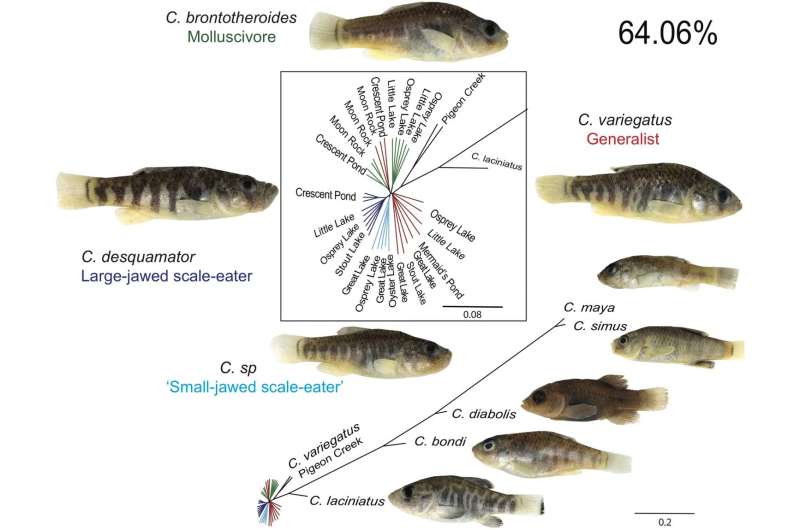San Salvador pupfish acquired genetic variation from island fish to eat new foods

Pupfish living in salty lakes on San Salvador Island were able to diversify into multiple species with different eating habits, in part, by interbreeding with pupfish from other islands in the Caribbean, report Emilie Richards and Christopher Martin, of the University of North Carolina at Chapel Hill, August 10, 2017 in PLOS Genetics.
Pupfish are small, brightly colored fish that commonly live in coastal areas and salty lakes and feed off of algae. But on San Salvador Island in the Bahamas, a group of pupfish has undergone adaptive radiation, a process where existing species rapidly evolve and differentiate into new species, to take advantage of a new environment. Where most pupfish species eat algae, one San Salvador species has a protruding nasal region that allows it to eat snails, while another has enlarged jaws that enable it to bite the scales off of other fish. To understand why these specialized species evolved only on San Salvador Island, despite the availability of scales and snails across the Caribbean, the researchers used whole genomes to identify regions of the San Salvador pupfish genome that came from outside sources. They examined 42 pupfish genomes collected from populations on San Salvador Island, two distant Caribbean islands, Laguna Chichancanab in Mexico, and Devil's Hole in California, to identify regions of the genome that have been exchanged between San Salvador Island and outside pupfish populations. They identified 11 gene variants in the San Salvador fish that came from other Caribbean pupfish populations, with four of these regions known to affect jaw size and shape, traits important in the evolution of their specialized diets.
The study suggests that multiple outside sources of genetic variation contributed to the adaptations found in pupfishes on San Salvador Island. These findings indicate that a complex suite of factors, including breeding with related species, in addition to new ecological opportunities, may be necessary for adaptive radiations to occur.
"The really intriguing thing here is that new species are assembled from different pots of genetic variation over a very large range. Our own species is likely no different," says study corresponding author Dr. Martin.
More information: Richards EJ, Martin CH (2017) Adaptive introgression from distant Caribbean islands contributed to the diversification of a microendemic adaptive radiation of trophic specialist pupfishes. PLoS Genet 13(8): e1006919. doi.org/10.1371/journal.pgen.1006919
Journal information: PLoS Genetics
Provided by Public Library of Science


















